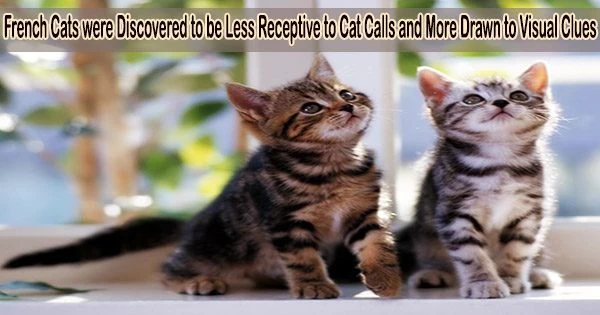The preferred feline behavior while meeting an unexpected human has been studied by researchers Charlotte de Mouzon and Gérard Leboucher of the Laboratoire Ethologie Cognition Développement, Université Paris Nanterre in France.
In the paper, “Multimodal Communication in the Human-Cat Relationship: A Pilot Study,” published in Animals, researchers examined four modes of human interactions vocal, visual, bimodal and a no communication control with a dozen cats living in cat cafés.
Twelve cats, chosen from a group of 18, were monitored during the study in two cat cafés in Bordeaux and Toulouse, France. The six who were left out of the study were either extremely cautious of people or simply did not like to contact with them.
The research team discovered through the examination of video recordings of cat-human interactions that the mode of communication had a major impact on how long it took for cats to approach the human researcher. Compared to vocal communication alone and the control condition of no communication, cats interacted substantially more quickly when using visual and bimodal communication.
Additionally, tail-wagging behavior was significantly impacted by the communication method. When compared to visual and bimodal communication modes, cats’ tails wiggled substantially more when the experimenter engaged in the no communication control, suggesting that they were less at ease. Compared to bimodal communication, vocal communication caused cats to wag their tails more frequently.
Before the café opened to the public, the experiment was carried out in the solitude of the morning. Two experimenters were present in the café. Experimenter 1 was sitting and engaged in communication according to each testing condition. Experimenter 2 recorded video of the interactions and sat still throughout the experiments.
For each test, the cat entered the room with their owner (café owners at both locations), who was asked not to communicate with the cat. The testing conditions were then initiated.
The four modes
In the no communication control, experimenter 1 did not look at or speak to the cat. She sat still and did not offer her hand. Six cats still were sufficiently curious enough to approach the experimenter.
With vocal communication, experimenter 1 alternated calling the cat by their name and making cat-specific calling noises, described in the paper as “…a sort of ‘pff pff’ sound, widely used by French humans for calling cats,” but did not offer her hand and looked upwards to avoid eye contact. Just one more cat came running in response to the calls than if there had been no communication.
The experimenter softly extended her hand to the cat as Ten approached in the visual mode, alternating her eyes between the floor and the cat. Because people and cats may regard narrowing of the eyes as positive communication, experimenter 1 used a neutral gaze and slow blinking patterns.
As a fourth form of bimodal (visual and verbal) communication, experimenter 1 extended her hand to the cat while alternately focusing her eyes on it and the ground, calling the cat by name and making cat-calling noises unique to France. Either nine cats approached, signifying an increased response to cat calls with a visual component or a decrease compared to just visual cues alone.
Throughout the testing period, experimenter 1 kept goodies hidden in her pocket, but she did not release them until the cat had approached within 10 cm of her. Within 75 seconds, if the cat did not approach experimenter 1, they were taken away and given a goodie at the door.
It is unclear what function the goodies serve in the study’s overall design, however it is normal practice to provide subjects rewards for taking part in experiments, albeit usually on humans.
Forty-eight video clips were generated, one video for each testing condition per cat, and coded using Behavioral Observation Research Interactive Software (BORIS). The Friedman rank sum test, a popular technique in computational biology, was employed in statistical analysis to examine how the cats responded to the various testing circumstances.
Contrary to expectations made when the study was being planned, the cats preferred visual communication over voice communication started by an unfamiliar human. This can indicate a good study design when the results ignore potential prediction bias.
According to the findings, cats show a clear preference for visual and bimodal cues over voice cues while being spoken to by unfamiliar humans. The authors propose that this discovery might be used as a foundation for useful advice on how to negotiate the rules of human-cat interactions.
















